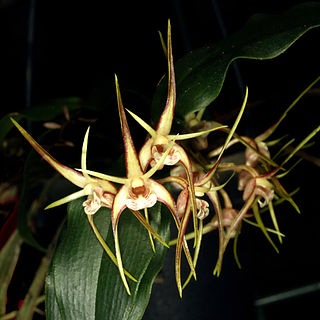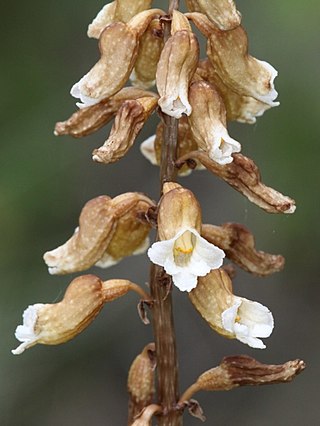
Gastrodia, commonly known as potato orchids, is a genus of terrestrial leafless orchids in the family Orchidaceae, about ninety of which have been described. Orchids in this genus have fleshy, upright stems and small to medium-sized resupinate flowers with narrow sepals and petals. They are native to Asia, Australia, New Zealand, central Africa, and various islands of the Indian and Pacific Oceans.

Didymoplexis, commonly known as crystal orchids or as 双唇兰属 , is a genus of terrestrial leafless orchids in the family Orchidaceae, about twenty species of which have been described. Orchids in this genus have swollen, fleshy rhizomes and thin, pale, upright fleshy flowering stems with resupinate, bell-shaped white or pale yellowish brown flowers. They are native to Africa, Madagascar, Southeast Asia, Australia and various islands of the Pacific.

Dendrobium tetragonum, commonly known as the tree spider orchid, is a variable species of epiphytic or lithophytic orchid endemic to eastern Australia. Tree spider orchids are unusual in having pendulous pseudobulbs that are thin and wiry near the base then expand into a fleshy, four-sided upper section before tapering at the tip. There are only a few thin but leathery leaves at the end of the pseudobulbs and up to five flowers on relatively short flowering stems. To allow for the variations in the species there are five subspecies and a variety, some with a unique common name.

Burnettia cuneata, commonly known as the lizard orchid, is the only species of the flowering plant genus Burnettia in the orchid family, Orchidaceae. It is a leafless terrestrial, mycotrophic herb with one or two leaf-like bracts and up to seven flowers that are brownish on the back and pink or white inside. It is endemic to southeastern Australia where it grows in dense thickets in swamps.

Erythrorchis, commonly known as bootlace orchids or as 倒吊兰属 , is a genus of two species of climbing, leafless orchids in the family Orchidaceae. Orchids in this genus are climbing or scrambling vines that cling by small roots, usually climbing on tree trunks. Many-branched flowering stems bear many densely crowded flowers.

Aphyllorchis queenslandica, commonly known as the yellow pauper orchid, is a leafless terrestrial mycotrophic orchid in the family Orchidaceae. It has up to twelve dull yellow flowers on a thin, fleshy, purple flowering stem and is endemic to tropical north Queensland where it grows in rainforest.

Gastrodia sesamoides, commonly known as cinnamon bells or common potato orchid in Australia and as the pot-bellied orchid or cinnamon sticks in New Zealand, is a leafless, terrestrial saprophytic orchid in the family Orchidaceae. It has a thin, fleshy brown flowering stem and up to twenty five drooping, brownish, self-pollinating flowers that are white inside. Growing in a wide range of habitats, it is native to Australia and New Zealand.
Genoplesium pedersonii, commonly known as Pederson's midge orchid, is a species of small terrestrial orchid endemic to the Blackdown Tableland in Queensland. It has a single thin leaf fused to the flowering stem and up to thirty small, greenish red to reddish, self-pollinating flowers with a dark purplish red labellum. The species is treated as Corunastylis pedersonii in Queensland.
Genoplesium validum, commonly known as the Blackdown midge orchid, is a species of small terrestrial orchid that is endemic to the Blackdown Tableland National Park in Queensland. It has a single thin leaf fused to the flowering stem and up to thirty five greenish-brown flowers with reddish stripes and a hairy labellum. This species is treated as Corunastylis valida in Queensland.
Chiloglottis trullata, commonly known as the triangular ant orchid, is a species of orchid endemic to Queensland, Australia. It has two dark green leaves and a single small, green or pinkish flower with a shiny, dark reddish black, insect-like callus surrounded by reddish club-shaped calli covering most of the upper surface of the labellum.
Aphyllorchis anomala, commonly known as the simple pauper orchid, is a leafless terrestrial mycotrophic orchid in the family Orchidaceae. It has up to twenty white flowers with purple markings on a deep purple flowering stem and grows in shady rainforest in tropical north Queensland.
Gastrodia queenslandica, commonly known as rainforest bells, is a leafless terrestrial mycotrophic orchid in the family Orchidaceae. It has one or two small, yellowish brown, tube-shaped flowers on a thin, brittle flowering stem and grows in rainforest in tropical north Queensland, Australia.

Didymoplexis pallens, commonly known as crystal bells or 双唇兰 , is a leafless terrestrial mycotrophic orchid in the family Orchidaceae. It has up to fifteen small, white, pinkish or brownish flowers on a fleshy yellow flowering stem. The flowers open one at a time, remaining open for a short time. Crystal bells is widely distributed in Asia, Southeast Asia, New Guinea, Australia and some Pacific Islands.

Epipogium roseum, commonly known as ghost orchid, leafless nodding orchid or 虎舌兰 , is a leafless terrestrial mycotrophic orchid in the family Orchidaceae. It has up to sixteen cream-coloured, yellowish or pinkish flowers with an enlarged ovary on a fleshy hollow flowering stem. This ghost orchid is widely distributed in tropical Africa, Asia, Southeast Asia, New Guinea, Australia and some Pacific Islands.

Erythrorchis cassythoides, commonly known as the black bootlace orchid, is a leafless climbing orchid in the family Orchidaceae. It has long, dark brown to blackish stems and groups of up to thirty yellowish to greenish, sweetly scented flowers and is endemic to eastern Australia.

Gastrodia entomogama, commonly known as the Brindabella potato orchid, is a leafless terrestrial mycotrophic orchid in the family Orchidaceae. It has a dark brown or blackish flowering stem with up to sixty brown, warty, tube-shaped flowers. It is only known for certain from the Australian Capital Territory.
Gastrodia lacista, commonly known as the western potato orchid, is a leafless terrestrial mycotrophic orchid in the family Orchidaceae. It has a thin brown flowering stem with up to fifty small, drooping, fawn and white, tube-shaped flowers. It grows in forest and woodland in the south-west of Western Australia.

Gastrodia procera, commonly known as the tall potato orchid, is a leafless terrestrial mycotrophic orchid in the family Orchidaceae. It has a robust, dark brown to blackish flowering stem with up to seventy cinnamon brown, tube-shaped flowers that are white inside. It grows in high rainfall forest in southeastern Australia.
Gastrodia urceolata, commonly known as white potato orchid, is a leafless terrestrial mycotrophic orchid in the family Orchidaceae. It has a pale brown, fleshy flowering stem and up to fifty five upright, white to pale brown flowers. It is only known from a single population near Atherton in Queensland.
Gastrodia vescula, commonly known as small potato orchid, is a leafless terrestrial mycotrophic orchid in the family Orchidaceae. It has a very thin, brittle, light brown flowering stem with up to three pale brown flowers that are white on the inside. It is only known from a small area near the border between South Australia and Victoria.










